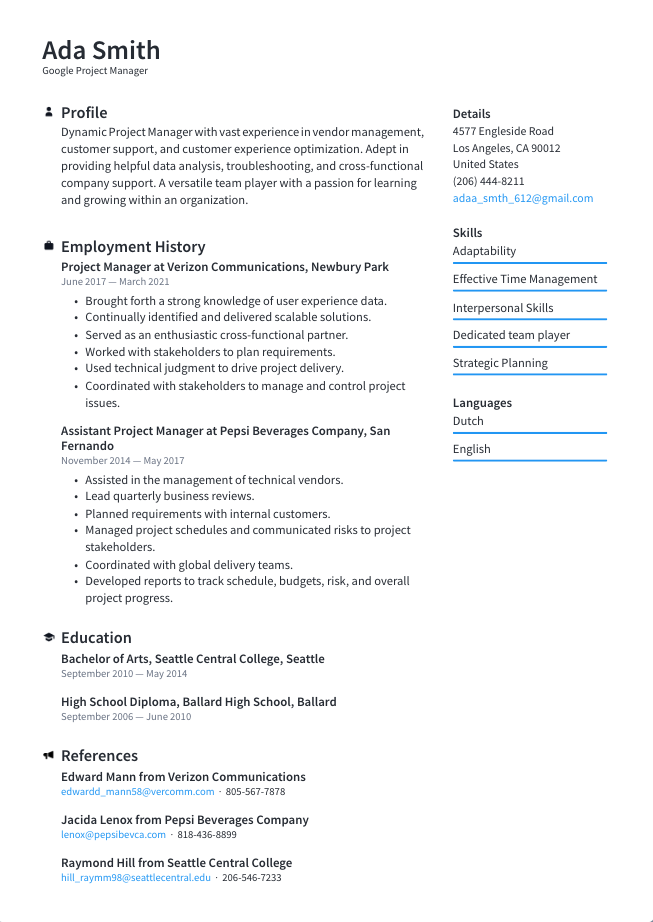Using a chronological resume to find a job
The term chronological resume is a bit of a misnomer, as this format actually puts employment history and education in reverse chronological order. That means you list your last or current job first, and your first job last.
Likewise, when using chronological order in reverse, you list your highest educational achievement first and earlier milestones below that.
The reverse chronological resume format is the one most commonly used, as it generally showcases a candidate’s most impressive experience first. If you’re a brain surgeon looking for a new position, it wouldn’t make much sense to start off your employment history with your first job at McDonald’s.
What’s the difference between chronological resumes and other resume formats?
The primary alternative to the chronological/reverse chronological resume is the functional resume format , which focuses on your experience and skills rather than a time-based narrative of how you acquired them. The hybrid resume format uses a combination of these two approaches.
For example, you may be a professional accountant who is looking for an “exit strategy” to pursue
your longtime passion for photography. If you’re preparing a resume to promote your experience doing
wedding, event and real estate photography, it would make little sense to provide a detailed
chronological list of your past jobs as an accountant. In this case, a functional resume emphasizing
your photography experience would be a better choice.
Let’s dig a little deeper into
the chronological resume to see if it’s the best choice for you. What this guide will cover:
- When to use a chronological resume
- Advantages and disadvantages of a chronological resume
- The format and structure of a chronological resume
- Writing the employment history and education sections
When to use a chronological resume
The chronological resume format is usually the best one to use if you have years of continuous experience in the field in which you’re seeking a job. This is especially true if you followed a more or less “normal” career path in which you progressed from an entry-level position to progressively more senior posts.
This format is usually used by people with a proven track record in their field, especially those who can demonstrate contributions they’ve made to their previous employers’ business. The emphasis is on experience, which is the main thing that employers are usually looking for in a job candidate.
There are several advantages to this resume format, including:
- It’s familiar to recruiters, so it’s easy for them to process.
- It’s easy to write, and there are lots of examples and templates to guide you.
- It demonstrates contributions made at previous jobs, which may be similar to what what the prospective employer is looking for.
- It shows experience with other companies in your field, demonstrating your connections and familiarity with the business needs and challenges.
- It tells a story of career progression, with growing experience, responsibilities and contributions.
Every coin has two sides. There are some potential disadvantages to using a chronological resume format as well, including:
- It may reveal gaps in your employment history that could raise questions for a recruiter.
- It may demonstrate “job hopping,” or having worked many jobs for a short amount of time, making potential employers wonder how long you might last at their company.
- If you’re changing careers, a long career in one field may do little to demonstrate your qualifications to begin a new one.
If these disadvantages outweigh the advantages, you may want to consider using a functional or hybrid resume format.
The structure and format of a chronological CV
A chronological resume (or CV, as this document is known outside the U.S. and Canada) should follow this basic structure and format:
• Header: Contains your name, occupation, address, email and phone
number.
• Summary/profile: 3-4 lines at the top of the page summarizing
what you do and why you’re good at it.
• Employment history: A listing of your
past jobs (last job first, first job last), with bullet points on what you achieved at each
one.
• Education: Your formal educational experience (highest degree first) and
any certifications in your field.
• Skills: A short list of the hard and soft
skills that make you good at your job.
• Optional sections: Membership in
professional organizations; hobbies and interests; references
Here is how a chronological resume should look .

Writing the employment history section
The employment history section is the main part of a resume where the reverse chronological format applies. In this section, list your current or last job first. Include the name of the company where you worked, the city, state and/or country where it’s located, what you did there and the years you worked there. (Precise dates are not needed.)
Under each employer, add a bullet list that describes what you did at each job. Don’t just say what you were “responsible for,” but what you actually accomplished. Be specific, using facts and figures wherever possible (dollar figures, percentage growth, number of employees you managed, number of clients you handled, etc.) Use strong action verbs: “managed,” “spearheaded,” “created,” “sold,” “organized,” etc.
You don’t have to include every job you’ve ever had, especially if they’re unrelated to the field in which you’re seeking employment. Include your most impressive and relevant jobs.
Writing the education section
The education section is the other part of your resume where the reverse chronological order needs to be used.
For example, if you have a Ph.D., list that first, along with the university, the field of study, and the year you earned the degree. Follow that with the same info on where you obtained your master’s degree, and below that do the same for your bachelor’s degree.
If you have a postsecondary degree, it’s generally not considered necessary to mention where you went to high school, although if you have room, it does no harm.
The education section can also be used to mention any certifications in your field, for example if you are a certified nursing assistant (CNA) or a certified public accountant (CPA). Participation in job-relevant continuing education classes, seminars and workshops can also be listed here, as well as membership in honor societies, clubs or extracurricular activities related to your field. If you had a stellar grade point average or graduated with honors, you can also say so here.
Tips for making the most of the chronological format
By using the chronological format, you are telling a story in reverse order. This may feel a bit unnatural, but if you review some of the hundreds of resume examples at ResumesMadeHere, you’ll see that this is totally normal.
Strive for visual balance and distribution in your resume, so that, for example, you don’t have one huge section and several tiny sections.
Remember that a resume/CV should almost always be one page only, so you need to be judicious about what to include. If you have extensive job experience, or if you’re highly educated, it may be impossible to list all your achievements and credentials.
Bullet lists, in particular, can take up a lot of vertical space. Consider arranging bullet lists in side-by-side columns, or simply summarizing your accomplishments in one text block (“Graduated magna cum laude; 3.8 GPA; member of Phi Beta Kappa honor society”).
If you’re still having trouble fitting everything onto one page, avoid resorting to formatting tricks like using a tiny font size or making the margins too small. Look for “widows” on your page, which is where one or two words spill onto a second line, making your ResumesMadeHere line longer. Thoughtful trims can usually eliminate these space-eaters.
If you experiment with different resume templates, you may also find that simply choosing a different template will make your resume fit onto one page.
Chronological resume summary
If you have years of continuous work experience in the field or industry in which you’re seeking employment, then the reverse chronological resume format is probably the right one for you. This will focus on your experience while also detailing your skills and education.
There is a wealth of resources available to you when you embark on writing a resume. These will provide you with examples and templates to get you started. You then just need to add the specifics about your professional background.
 ResumesMadeHere
ResumesMadeHere